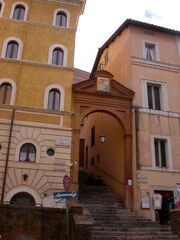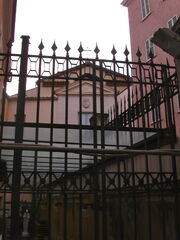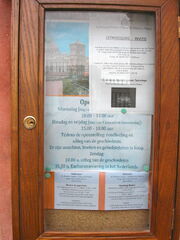Santi Michele e Magno is a 12th century national church, very heavily restored in the 18th century, hidden away just east of St Peter's at the west end of Borgo Santo Spirito. The postal address is Largo degli Alicorni 21, in the rione Borgo. Pictures of the church at Wikimedia Commons are here. There is an English Wikipedia page here.
It is the national church of the Netherlands.
Name
The unique joint dedication is to St Michael the Archangel and to St Magnus, bishop of Anagni. (Beware of erroneously reading the name as San Michele Magno, or "St Michael the Great" in Italian.)
The church is also known in Dutch as the Kerk van de Friezen, "Church of the Frisians".
History
Schola Frisonum
The foundation of the church is not documented, but it is confidently surmised that it originated as the chapel of the Schola Frisonum. This is better translated as "Expatriates' Club for Frisians" rather than the more usual "School". It was a place where Frisian pilgrims and expatriates could lodge, meet and arrange their affairs, and was one of four such Germanic national institutions around the Old St Peter's in the early Middle Ages (the others belonged to the Franks, Lombards and Saxons; the last one has a memory in Santo Spirito in Sassia).
This one was first recorded in 799, although the church is only mentioned in 854. Undocumented tradition claims that an earlier church here was built by St Boniface (675-754).
A thousand years ago, Frisia consisted of the coastal parts of the Netherlands and what is now called Friesland in Germany and Denmark. Although its political identity was ephemeral, back then it had a linguistic one and a proto-national identity accentuated by the missionary activities of St Willibrord, Apostle of Frisia, who fixed his cathedral at Utrecht.
Middle ages
Saracen pirates raided Rome in 845, and plundered St Peter's and the surrounding area. As a result a defensive wall was built around the schola, and remains may still be found of this. However, the old church was nevertheless apparently badly damaged or destroyed in the Sack by the Normans in 1084.
Hence it was completely rebuilt in 1141, and the surviving campanile added. At this poing the relics of St Magnus of Anagni were enshrined, and the church's dedication hence changed when the new building was consecrated by Pope Innocent II . Allegedly Frisian pilgrims mistook this Italian bishop for Magnus Forteman, an 8th century hero of theirs. They managed to get hold of his relics, but the pope heard about it and prevented them taking them back home -except for one arm. As a compromise, the expatriate community in Rome was allowed to keep the rest.
Pope Eugene IV suppressed the schola in 1446, and from then on the church belonged to the Chapter of St Peter's. It was entrusted to an Archconfraternity of the Blessed Sacrament, and became a parish church in 1508.
Remodelling
There was a major restoration between 1756 and 1759. The architect was Carlo Murena, who in his remodelling preserved the mediaeval plan.
Part of the complex that resulted was the Scala Santa, a steep flight of thirty-three stairs from the Borgo Santo Spirito straight into a side chapel of the church. Like the more famous Scala Santa stairs at the Lateran, an indulgence is offered here if you climb them on your knees. (Don't confuse this way in with the normal one, mentioned in the note on access below.)
Modern times
A major fire in 1860 caused serious damage.
In 1929 the church was made extraterritorial; that is, it remained part of Italy, but was from then on administered exclusively by the Vatican. The parish was suppressed, initially merging with Santo Spirito in Sassia (the only parish in the Borgo is now Santa Maria in Traspontina). The confraternity remained in charge.
Since 1989 the church has been used by the Dutch community in Rome. In 1990, UNESCO put the church on the World Heritage List as part of its inclusion of the Extraterritorial Properties in the Centro Storico.
A major new restoration was completed in 2011, and the church now looks very smart and in good condition.
Exterior
Layout
The church is surrounded by taller buildings to north and west, and is invisible from the street. It is perched on the northernmost outlier of the Janiculum hill, which is why access is by stairs.
It is an aisled basilica having a nave of six bays, a sanctuary occupying a further bay and an external segmental apse. Chapels flank the sanctuary at the ends of the aisles, the left hand one giving access to the Scala Santa. The first bay of the nave is flanked by a pair of custodians' chambers, but the right hand one now gives access to the so-called Room of Titus Brandsma and also a little terrace with a good view of the campanile.
One of the best depictions of the exterior is by the Dutch artist Maurits Cornelis Escher , more famous for his works inspired by non-Euclidean geometries. It is in the National Gallery of Canada, and there is a weblink (see below).
Campanile
The Romanesque campanile is more than 20 metres high, and was built around 1150. It was in bad shape for a long time, but was restored in 1993. It is located next to the right, south aisle of the church, near the entrance, and is at an angle to the major axis (Escher got this wrong when he showed it parallel to the axis).

The entrance portal; the church is up the stairs and on the left.
It is difficult to get a view of it without visiting the church, and the photos online have been taken from neighbouring buildings. There is a view, albeit distant, from the Castel Sant'Angelo. The best view would be from the south, from the grounds of what was the Villa Barberini and is now a private sports ground attached to the Pontifical Urbaniana University. You need a personal contact to get in here.
If you can get into the church, turn right immediately upon entering and go up the stairs to a little terrace next to the campanile in order to see it.
Despite its lack of civic presence, the campanile is a high quality design. It is in brick, and has three storeys above the roofline. Two opposing faces of each storey have arcades of three arches, separated by stone columns with imposts. The other two faces have two arches. String courses run round the tower at the level of the arch springers, and are continued over the arches, and there are projecting cornices separating the storeys as well.
Façade
The façade is very simple. There is an entrance porch with parvise above, which forms a narrow two-storey frontage. The first storey just has an arched portal without imposts, and the second one a rectangular window with a heraldic coat-of-arms above. The storeys have very shallow Doric pilasters at the outer corners, and are separated by an entablature frieze without architrave or cornice. There is a triangular pediment, which is now blank but looks as if it once contained a fresco. Everything is rendered in bright white.
Peeping over this façade is the nave end of the church itself, which has a segmental lunette window in its pediment.
Interior
There is a nave with aisles, and a flat wooden ceiling which runs uninterrupted from the entrance end to the triumphal arch of the apse, covering the presbyterium as well.
The arcades are interesting; there are three large arches on each side, but these are separated by two rectangular openings in lieu of arches. Above the rectangular openings are large tondi showing saints, with two more near the triumphal arch and also the entrance making eight in all.
Above the arches are rectangular clerestory windows, with two more near the triumphal arch again making a total of eight. These are separated by panels with stucco decoration, and sit on cornices. These side wall cornices are supported rather awkwardly by Doric pilasters in shallow relief, rising from the springers of the arcade archivolts.
Before the 18th century restoration, each arcade had seven ancient marble columns and the present pillars still apparently contain these.
The ceiling is coffered, and is tricked out in grey, white and orange. There is a large stucco relief in the middle, showing the Keys of St Peter being held by angels. The keys are not crossed, which is the heraldic signifier for the Chapter of St Peter which owns the church and which is commemorated in the inscription next to the triumphal arch.
Over the entrance is the bow-fronted cantoria or gallery for musicians, which has a solid balustrade embellished with heraldry. In the far wall of this is the organ, inserted into a pedimented aedicule crowned by a large stucco coat-of-arms with festoons. The organ itself has been recently ascribed to Giovanni Corrado Verlé (1701-77).
In the left hand corner by the entrance is an epigraph of around 1300, describing the arrival of the relics of St Magnus.
Near the entrance also is the font, unusual because the church is not parochial. It was originally carved for a church in Maastricht in 1925, and provided with a gilded metal cover by Bert Kreijen. It shows St Servatius, founder of the city's diocese.
Since the recent renovation the last two bays of the nave have been occupied by a choir, with seating salvaged from that provided for the bishops at the Second Vatican Council held in St Peter's.
Tondi of saints
The eight tondi mentioned have fresco portraits of saints, certain of which were important in the evangelization of the Netherlands. They are helpfully labelled, and are: St Boniface, Pope St Leo III, St Abundius the Sacristan (of St Peter's), St Willibrord, St Charles Borromeo, St Theodore the Sacristan (also of St Peter's), St Swithbert and Bl Anthony Fatati, bishop of Ancona.
These tondi are anonymous, 18th century.
Sanctuary
The sanctuary is structurally part of the nave, but ends in an apse with its own triumphal arch. This is supported by a pair of narrow Doric pilasters with imposts, the capitals and imposts of which are carried around the apse wall to form an entablature.
The aedicule of the high altar is set right into the curved apse wall, and has a pair of Corinthian columns with gilded capitals, in what looks like verde antico. The triangular pediment overlays the entablature, with the apse conch above.
The altarpiece is by Niccolò Ricciolini (1687-1759), and shows the two patron saints. Also featured is Castel Sant'Angelo, a reminder of the vision of the archangel to Pope Gregory the Great there (hence the name).
Some care has been taken with the altar pro populo, in front of the high altar. It is made up of an ancient carved marble sarcophagus, with an odd epigraph reading: Hic lapis est in quo natu[m] Te[m]plo obtulit olim more Hebreoru[m] Virgo Maria suum ("This is the stone on which the Virgin Mary brought her offspring into the Temple according to the former custom of the Hebrews").
Right aisle
The right hand aisle contains a side altar dedicated to the Immaculate Conception of Our Lady, with a good stucco depiction of her in high relief.
Beyond is a memorial to Nicola Spedalieri 1795, with a good painted portrait.
Chapel of Remembrance
At the end of the aisle is the Chapel of Remembrance, dedicated to the memory of deceased patrons of the church. Beyond this is a separate room, the so-called Coemeterium, which is dedicated to the memory of members of the Eucharistic confraternity.
Chapel of Our Lady of Sevenwouden
At the end of the left hand aisle is a chapel dedicated to Our Lady of Sevenwouden. There is a copy here of the statue of her, venerated at Bolsward.
Here is also a partition wall made up of bricks from ruined convents and churches in the Netherlands, which were collected over several years by Lodewijk Damsma.
Scala Santa
The Scala Santa, a steep set of stairs from the Borgo Santo Spirito into the above chapel, was restored in 2000. Opposite its top end is a wall crucifix.
It is a devotional copy of the famous Scala Santa near the Lateran, which is a staircase of twenty-eight marble steps allegedly used by Christ during is judgment by Pilate at Jerusalem. A plenary indulgence is offered to those climbing the staircase on their knees, while meditating on the Passion. As a special concession, this indulgence also applies to the staircase in this church.
In the street, you will find a pedimented doorway with a tondo over it, showing a mosaic of Jesus the Nazarene. This is always locked, but you can access the staircase from its top.
The original staircase at the Lateran is clad in well-worn wood, and climbing up it on your knees is not too uncomfortable. However, the staircase here is in uncovered marble and is much more challenging. The writer has done both, and can vouch for this!
Left aisle
The most notable burial in the church is of Anton Raphael Mengs, a great German painter of the 18th century, and his memorial at the end of the left hand aisle is by Vincenzo Pacetti, 1778. It has a cameo relief portrait guarded by putti.
The left hand aisle also contains a side altar dedicated to SS Peter and Paul, and the altarpiece depicting them is by Ludovico Stern, 1709-77.
Here also is a good Baroque wall memorial to Leonardo Santi, 1668. The painted portrait is engaging, although unflattering.
Titus Brandsma room
Attached to the church is the so-called Titus Brandsma Hall, which is a visitor facility for lectures and receptions. It contains a modern bust of Brandsma, martyred by the Nazis, which is by Josephine Kortman-Hilders. Access is up the stairs at the bottom right hand corner of the nave.
Crypt
A burial crypt was made between 1618 and 1628. An interesting thing about this crypt is that men, women and children were buried separately. Three signs marked virorum, mulierum and infantium mark their respective sections.
Access
You may have trouble in finding the church, and also in finding it open when you do if you just turn up. Firstly, look for a tall arched portal with a triangular pediment containing an icon with its own little segmental pediment. This icon is in mosaic, and shows the Annunciation.

The only view of the church when it is shut, at the top of the stairs.
Go up the stairs, through a gate in a set of railings and turn left.
According to the church's website (July 2018), the standard opening hours are:
Tuesdays and Fridays 15:00 to 18:00, except between 1 January and Ash Wednesday;
Wednesdays 10:00 to 13:00 WHEN THERE IS A PAPAL AUDIENCE;
Saturdays 10:00 to 13:00;
Sundays 10:00, for Mass.

The opening times, in Dutch, Italian and English.
Guided tours are given, and you can buy postcards and books.
Liturgy
Mass is celebrated in Dutch on Sunday at 10:30, preceded by a talk on the church if there are pilgrim groups present.
You can have coffee with the worshippers after Mass. If you cannot speak Dutch, you will find that most Dutch people nowadays speak good English. They are friendly here, and are proud of their church.
See the church's website for the horarium here, for other liturgical celebrations ("dagmis" means "day Mass").
External links
Blog with good photo of interior
"Medioevo.roma" article on mediaeval church (in Italian)
"Romasegreta" web-page (with good photo of campanile)
| National churches |
| Argentina | Armenia I | Armenia II | Belgium | Canada | Croatia | Denmark | Ethiopia I | Ethiopia II | France | Germany | Greece | Hungary | Ireland I | Ireland II | Italy/Calabria | Italy/Camerino | Italy/Lombardy | Italy/Lucca | The Lebanon | Mexico | The Netherlands | Norway | The Philippines | Poland | Portugal | Romania | Russia | Spain | Sweden | Syria | Ukraine I | Ukraine II | Ukraine III | United Kingdom | United States |